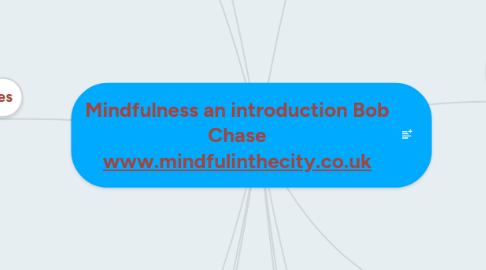
1. 1: The "Doing" or "Reactive" Mode
1.1. Living like a "To Do List"
1.1.1. Thinking of shopping when planning
1.1.2. Thinking of cooking when shopping
1.1.3. Thinking of eating when cooking
1.1.4. Thinking of conversation when eating
1.1.5. Thinking of holidays when washing up
1.2. Qualities of the Doing Mode
1.2.1. Constant thinking
1.2.2. Self critical thinking
1.2.3. Feeling life is a relentless struggle
1.2.4. Reacting to events uncontrolably
1.2.5. Negative thoughts proliferate
1.2.6. Being on "Automatic Pilot"
1.2.7. Over analysis of problems
1.2.8. Constant striving and sometimes perfectionism
1.2.9. Believing all our thoughts to be true
1.2.10. Avoiding discomfort and difficulties
1.2.11. Choosing depleting or damaging activities as an escape
1.2.12. Happiness in the future .. postponed
1.2.13. Detachment from the body
2. 2: Consequences of the Doing Mode
2.1. 10% of population can expect to become clinically depressed in next 12 months .. recurring in 50% of people
2.2. Sleep problems and disorders
2.3. Exhaustion
2.4. Poor decision making
2.5. Not caring for your body
3. 3: The science of the Doing mode
3.1. Our stress system is in High Alert ALL THE TIME
3.2. High dosages of stress hormones e.g. Cortisol
3.3. Neuro-Plasticity - we can change our minds!
3.4. Changes in Grey Matter - evidence of changes
3.5. Promising Research and evidence to explain the effects
4. 4: The Being Mode - an alternative
4.1. Qualities of the being mode
4.1.1. Ability to make concious choices
4.1.2. Using all your senses to perceive the world
4.1.3. (non passive) Accepting rather than striving
4.1.4. Ability to see thoughts clearly for what they are
4.1.5. A willingness to approach difficulty
4.1.6. Presence in the current moment
4.1.7. Choosing nourishing activities
4.1.8. Skilled responses and decision making
4.1.9. Better relationships
5. 5: The Outcome of the Being Mode - the science
5.1. Anxiety and Depression decrease
5.2. Reduces Chronic Stress inc Hypertension
5.3. Can help with management of chronic pain
5.3.1. Better Relationships
5.4. Boosts the immune system
6. 6: Choice of "Doing" or "Being" mode?
6.1. Re-Balancing between Doing and Being
6.2. Conscious choice
6.3. "Tasting" the being mode
7. 7: Mindfulness Practices
7.1. Qualities of practices
7.1.1. 1: PAYING ATTENTION
7.1.1.1. With wakefulness
7.1.1.2. Irrespective of how you feel
7.1.1.3. To all experience - as it arises
7.1.1.3.1. Pleasant experiences
7.1.1.3.2. Unpleasant experiences
7.1.1.3.3. Pains and pleasures
7.1.1.3.4. Dullness and boredom
7.1.2. 2: ON PURPOSE
7.1.2.1. Consciously
7.1.2.2. With clear intention
7.1.2.3. Even when you feel you are failing
7.1.3. 3: IN THE PRESENT MOMENT
7.1.3.1. Not of the future or the past
7.1.3.2. In "Real Time"
7.1.4. 4: NON JUDGEMENTALLY
7.1.4.1. With self-compassion
7.1.4.2. With kindness to yourself
7.1.4.3. Suspending self-criticism
7.1.5. 5: "As though your life depended on it" JKZ
7.2. Changing unhelpful habits
8. 8: Mindful of what when?
8.1. Foundations
8.1.1. MIND - Thinking and thoughts
8.1.2. BODY - Sensations and senses
8.1.3. HEART - Feelings and emotions
